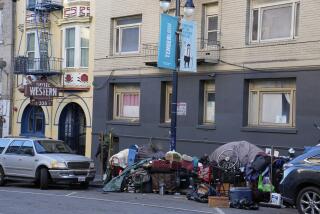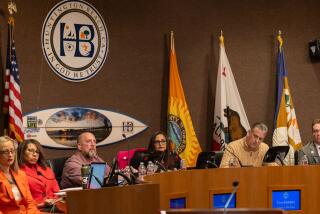Reaching Out to Steer Runaways From the Street
HUNTINGTON BEACH â The first wisps of chill arrive on the late-night breeze as two teenage girls, sitting on a sidewalk bench, watch the downtown slowly come alive.
One of them amateurishly holds a cigarette, her fingers straight and stiff. Up and down Main Street, groups of teens, some perhaps from a nearby âsquatâ where they live with other runaways, begin to roam the area.
A stranger, an older man, approaches the girls on the sidewalk bench and hands them a piece of paper.
âNeed help?â it asks. âCall us. Huntington Youth Shelter. 714-847-KIDS.â
The man says: âIf you know of anyone who needs food or clothes or someplace to stay, have them give us a call.â
The girls look over the flier and seem to understand. The one with the cigarette wonders who the shelter will notify. âWhat about the parent thing?â she asks warily.
Quite likely, they are runaways, among thousands of children under 18 who abandon parents, home and school and drift into Orange County every year. Among an estimated homeless population of 12,000 to 15,000 in Orange County are as many as 6,000 children, many of them runaways.
Teen drifters from around Orange and Los Angeles counties often end up in Huntington Beach, still known as Surf City. They want a place safer than Hollywood--perhaps the premier magnet for runaways--that offers the same benefits: warm weather, peer acceptance, public gathering places and an endless party of drugs, drinking and sex.
When children show up here, itâs easy to blend in. This makes runaways hard to identify. Outreach workers know where they are but not always who they are.
This is not, after all, âOliver Twist,â and the homeless kids donât always show up in town sporting rags and pathetic expressions. These days, they look like everyone else.
âItâs not unusual to see a runaway come into a shelter with decent clothes, decent shoes and a pager,â says outreach worker Phillip Ferguson, 23. âTheyâre really hard to spot.â
Still, outreach workers try. In a new effort to track and treat runaway and homeless youth, Ferguson and co-worker Amie McGoon, 32, travel through Surf City and surrounding cities to find the runaways, let them know that help is available and, if possible, coax them into the Huntington Youth Shelter or steer them toward other public aid.
Day after day, Ferguson and McGoon seek out runaways, castaways and those who might know them. They meet with students who know of classmates having problems at home. They travel with police to find new hangouts and âsquatsâ--boarded-up buildings, abandoned houses, parks or even freeway overpasses where groups of kids establish a makeshift dwelling. They approach kids on streets and in parks, on beaches and at shopping strips.
Their work is funded by a $315,000 federal grant. Now in its second month, it is the first such outreach program for runaway teens in Orange County.
The 10-bed shelter, just 3 years old, began as a community project run by volunteers. Now operated by the Volunteers of America, the Huntington Youth Shelter attempts to get children off the streets and back into school and to mend differences at home, if possible. It also arranges for longer-term living situations outside the home.
âWe are not âthe system,â â says Karyl Winslow, 48, director of the shelter, referring to the public web of foster care, mental institutions and the juvenile justice system. âWe are the stop-gap before the system. In a lot of cases, we are the last effort where somebody has intervened before a youth makes a critical mistake.â
Julie, a 15-year-old Orange County girl, says she had quit going to school and was running away from her parents and from home when she was steered to the shelter by friends in October.
âI think I needed someplace to cool off,â she says. âAt home, I had too much stress. I couldnât get along with my parents. At the shelter, they were like friends. They listened and seemed to understand.
âNo one pointed a finger at me. No one told me what I had to do or what I could or couldnât do. They let me figure it out for myself.â
Ferguson, who survived his own troubled teen years and understands the constant crossroads those years represent, holds out hope daily that he can offer a drifting teen a second chance.
âWe donât judge them,â he says. âWeâre not going to lock them down. Weâre not a law enforcement agency. But they need an option--something to buy time, help them get their life back together.â
Enticing runaways into shelters is difficult. But finding locations where they hang out is less of a challenge. Kids want to be around other kids.
Coffeehouses, surf shops, mini-marts, laundries and any place with video games draw groups of teens who in turn provide a powerful social attraction for runaways.
Huntington Beach offers all of these places as Orange Countyâs apex of youth culture.
The Huntington Beach Skate Park, across Yorktown Avenue from the Civic Center, is huge with the youth scene. The place where many top skaters first learned their moves, it thrives some nights despite the cityâs 10 p.m. curfew. After police sweeps, teens leave, curfew tickets in hand, only to sneak back in when the cops are gone.
Outside Ocean View High School, Ferguson chats with students walking home from school. A 16-year-old named Danielle, wearing heavy chains around her neck, intricate eye makeup and a thick chrome stud piercing her lower lip, takes a flier with the Huntington Youth Shelter hotline number and asks for several more.
âI know a lot of kids who need these,â she says. âA lot of my friends are squatters.â
She meets them at punk rock shows from Newport Beach to Los Angeles. âSometimes, they live with me for a couple of days at a time,â she says.
Downtownâs older housing stock, particularly beach bungalows, offers plenty of places for kids to sleep: alleyways, makeshift shacks, empty guest houses, backyards, gazebos, garages and unlocked cars.
Plus, the area thrives with young adults who share teensâ party-minded lifestyle of sex, drugs and surfing and often offer a couch to sleep on, food, company and showers. Not straying from beach culture, the practice of staying with others around here is called âcouch surfing.â
âI would assume a nice kid in downtown Huntington Beach could find somewhere to spend the night,â says Sgt. J.B. Hume of the Huntington Beach Police Department.
Driving down Pacific Coast Highway in the shelterâs minivan, Ferguson points to a boarded-up motel. âThereâs going to be kids living in there,â he says. âItâs perfect for a squat.â
But he doesnât intrude. âThatâs like invading their home. Theyâre apt to become defensive.â
Still, early in the day, heâll walk up, drop off a stack of fliers and leave. Sooner or later, one of the runaways, and possibly more, will call.
Ferguson hopes they will. Thatâs because life on the streets, even in Orange County, can be ugly. Drugs and prostitution, crime and predators are constant perils.
Valarie, 16, wears a wedding band to fend off aggressive men. She typifies the tangle of family and personal problems that add up to teenage homelessness. She was taking methamphetamines until a year ago and got pregnant five months ago. Her 21-year-old boyfriend has left the state. Her 43-year-old mother lost her job of 13 years, and her estranged father stopped paying child support.
She ended up at the Huntington Youth Shelter last week. Her mother is homeless too.
âMe and my mom donât have a place to live,â says Valarie, whose baby is due in March. âWe lived on the streets, and since I am pregnant she thought Iâd be safer here.â
A family environment made the shelter the best place she knew to spend Thanksgiving, and she hopes to find help with her goals: finishing her education at an adult school in Tustin, attending college and opening a business.
âI am always positive when things are down,â she says. âHow can I not be? I donât want to be depressed. Thatâs no fun.â
More to Read
Sign up for Essential California
The most important California stories and recommendations in your inbox every morning.
You may occasionally receive promotional content from the Los Angeles Times.










